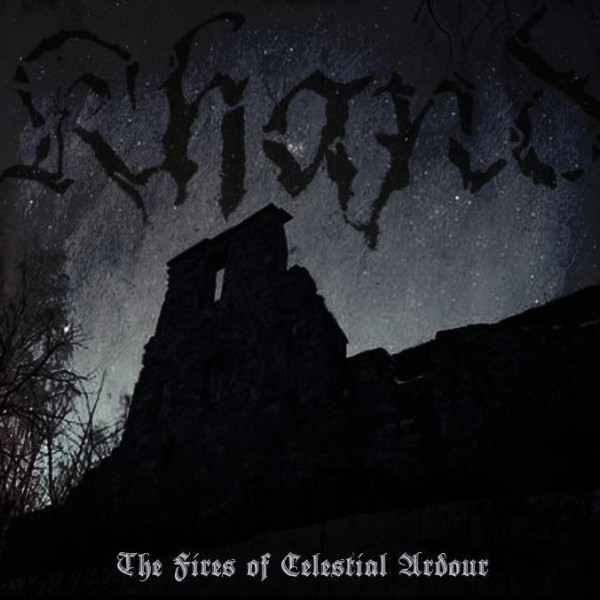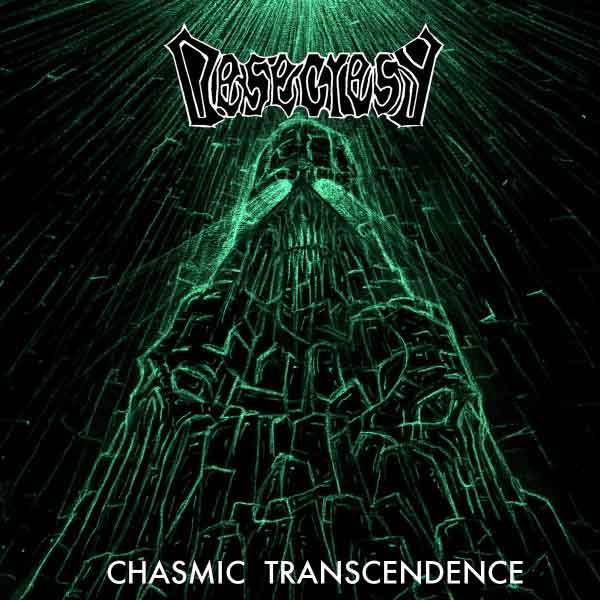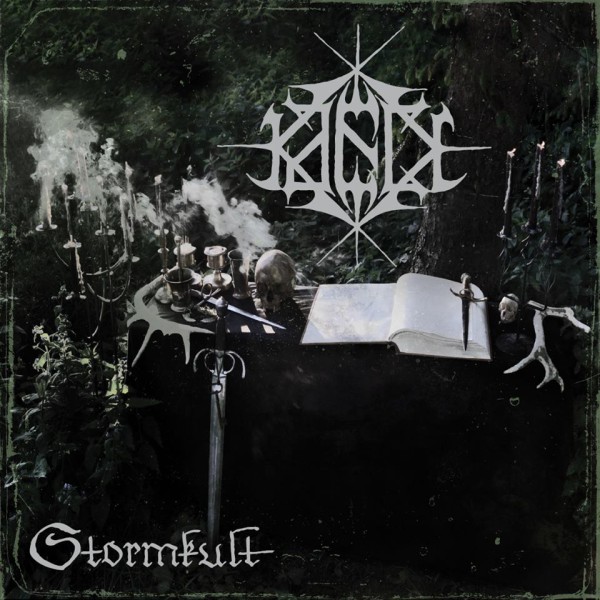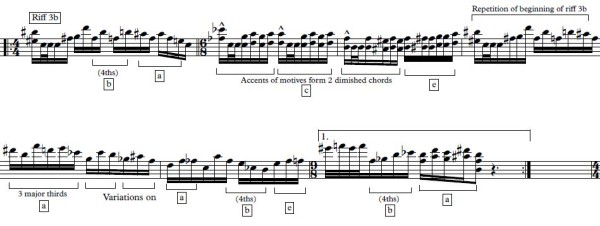It is our regrettable duty to report that Frank Dancsecs, founder of the legendary ACES Records in Tampa, Florida, has passed away on June 29, 2015. ACES was a gathering point for the early Florida death metal scene and invested support and belief in the early genre when it was rejected by most others.
1 CommentKhand to release two new upcoming works
Necrotic dungeon synth/cosmic ambient band Khand plans to release two upcoming albums. The band issued the following statement:
2 CommentsThis hasn’t been announced yet, but there will be two albums released right around the same time: the aforementioned space/Mars concept album, and also one with Medieval/Fantasy elements. I have been working on both at the same time; recording the Mars album slowed down as I had to purchase some new equipment and and a new rig. But alas, I hope to have both of them out soon. As always, thanks for the support. There are still cassettes available as well, please contact me here if you would like some.
Album arts and/or newer track to be released soon.
Tags: Ambient, cosmic ambient, dungeon synth, khand
Desecresy selling past albums
Spacious death metal band Desecresy are selling copies of their past albums for anyone who has discovered them late and wants to capture all three, which are reviewed here. The band writes:
1 CommentStill available from us:
Arches of Entropy CD 10 €
The Doom Skeptron CD 10 €
The Doom Skeptron LP 15 €
Chasmic Transcendence CD 10 €and the last Arches of Entropy t-shirt 15 €
Shipping will be added to the price
Contact via Facebook or desecresy@hotmail.com
Tags: death metal, desecresy
Requiescat in Pace: Jaime Gonzalez, Hogwild Records, San Antonio, Texas
It is our sad duty to report that Jaime Gonzalez, manager at San Antonio, Texas, metal record cavern Hogwild Records has passed away on July 4, 2015 after a long battle with cancer. For those who remember Jaime, he was an affable man who adored heavy metal and did not hesitate to extend a kind word to fellow metalheads. He will be missed.
1 CommentTags: hogwild records, jaime gonzalez, obituaries
More on Stormkult
Following up on Brett Steven’s review of Kaeck’s Stormkult, the present review starts off where he left off: the fusion of styles in Stormkult that are brought together under one unifying banner. The truth is that trying to split this album into its influences is almost pointless as it broke them down to such atomic and almost indivisible parts to build something that is completely their own. We may hear a trace of what Sammath or Kjeld sounds like almost only because we were told that members from these bands participate here. Otherwise, we would be hard pressed to find concrete influences.The previously mentioned review does a very good job at describing the album both in an evocative way, as in describing a picture and by summoning the presence of other bands as to give the reader some idea of how Kaeck goes about building their music, but in no moment does this imply that Kaeck actually sounds like any of them (except, of course, for the fact that they are all black metal).
Kaeck’s “sound” can be broken down into the layered functions that the instruments fill. First we have the drums at the bottom. These are used more like a heartbeat rather than a metronome. A typical background black metal drum pattern will keep the beat with standard beats, but here the drum patterns are reduced in such an intentional manner to something that can only be described as primitive battle drums whose sole function is to drive deep and resounding vibrations in the martial host’s body. Guitars distorted to the poing of disfugurement provide the thickness of the sound, notes and chords themselves being barely recognizable through the fuzz and chaos of frequencies bent to the whims of an unfathomable will. Riding the maelstrom of riffs comes a coarse voice which simultaneously commands us out of lethargic inaction and commends us to embrace the defying and righteous — though heretical — mission of the Angel of Light. A luminescence that, contrary to what the waylayer Paul would have us believe, is in all truth the true essence of that entity shrouded in damned robes of exhile. A garb worn as camouflage to avoid the tyrannical embrace that paralyzes thought from within in exchange for blissful mental atrophy. Echoing across the catacombs that serve as an imaginable setting for Stormkult we can hear a keyboard that outlines short melodic motifs counterpointing and delineating the whole in a loop, only changing with the tempestuous guitar and arising from within its bowels only to go back to them as a lost, desperate soul attempting to escape imminent destiny only be pulled back by a reality that admits no denial.
What we have now, is a static picture of Kaeck. But the enduring power of Stormkult resides in the living movement through temporal dimension that music is. Affirming dominance over the elements of music, bending them in an abuse characteristic of a necromancer trespassing the bounds set by divine order, we hear the violent plight of Godless Arrogance coming to fruition in the reining in of a beast of unnatural origin. The experience through which Kaeck hauls our terrified soul appears at first as an indistinguishable blur. It is only after our eyes have time to adjust in the dim light pushed into corners by an overpowering darkness that we see a pattern emerge in the frescoes on the walls splattered by blood old and new. And from the synchronized layers of sound we hear subtle transformations that a moment ago seemed to comprise only one motif in repetition. Once we latch on to the combat-inciting beats, and the voice guides us over the patterns of the riffs as the melodies produced in the keyboard and a soloing guitar move in and out of our field of view, we start to envisage this humble temple in all the dimensions conceived by its creator: the evolving motifs on the timeline as well as the entities represented in the melodies existing as reflections of the riff itself on parallel worlds.
While any music can rightfully pronounce themselves as comprising all necessary dimensions, seldom do creators actually think fully in all of them. It is usually the case that the whole is forgone to give prominence to one of the elements, no matter what is claimed. When the goal is the whole, all the parts are cared for in an obsessive manner in attention to how they affect the whole and not according to how they stand on their own which often leads to an imbalance in the relation of the parts that obstructs communication, for what is intended by the whole is either distorted or fades into the background to give way to the prominence of egos. These considerations must include the temporal relations of things, it is not just how the instruments in the present riff interact, but how they interact with different parts throughout the song. Balance, then, does not imply a static situation where everything is still as a result of equating forces pulling in different directions, rather, a stable condition is attained without which a clear direction would be very difficult to follow. And although one should also keep in mind that there is no one singular formula to approach composition, each tradition has its guidelines based on conventions without which music would only be what modern popular music wants it to be: personalized pleasure fountains.
Kaeck approach this ideal of balance in all dimensions from the particular filter of minimalist and raging black metal. In Stormkult the tempered voices of the outward chaos of late Sammath and the adventurous impulse of Kjeld are not just channeled but fused and distilled to the point where only the most basic of essentials remains. This is why although we cannot actually hear Sammath or Kjeld in the music (apart from predictable superficial observations like “the vocalist is the same” or “it’s also aggressive black metal”), their approaches to music construction — from the naturalistic violence of Sammath that defines consistent yet distinct riff-writing to the refined delicacy of movement of Kjeld provided by a melding of sections through simple yet perspicacious rhythmic and melodic devices that makes such changes almost imperceptible, Stormkult is the titan born of a god and a primordial monster.
https://www.facebook.com/Kaeckhorde?fref=ts
7 CommentsTags: 2015, Black Metal, kaeck, kjeld, minimalism, sammath, Skym, Stormkult
Cervecería Cuauhtémoc Moctezuma, S.A. de C.V. – Dos Equis Special Lager
This drivel sells under import prices when it is essentially repackaged American beer. Gone are the Dos Equis highlights of the 1980s, when XX brown was a thick flavorful beer that provided an alternative to the dreck on the big shelves. Now you get the watery drivel that happens when a firm decides to maximize profit based on the — not lack of information — low ability to discern shit from gold that identifies the average consumer. This liquid tastes pulpy and soapy and has low alcohol content, or at least low effect. It may be because if not drunk absolutely cold, it resembles the pulque substance they make in prisons more than beer. Any pretense that this is superior to Michelob are nonsense; it is a pale shadow of its former self, made fruitier and vapid so that Average Citizen Idiot can bob his head while listening to the “edgy” Ramones cover band at his local icehouse and talk up the fat women hanging like vegetative overgrowth around the bar, as everyone around him imitates past edginess in an attempt to seem like anything but the corporate stooges they are. Seriously, this is Mexican-flavored Miller Lite. Every burp feels like a vomit about to happen, except it is just the taste of this bilgy sweetened pond water masquerading as beer. Speaking of corporate stooges, this beer is undrinkable, unless you have already numbed your taste buds to the point of accepting the mediocre as the norm.
Quality rating: 1/5
Purchase rating: 1/5
Tags: beer, dos equis, special lager, xx
Reflections on Nadia
I’ve been meaning to write a review on Nadia for some time but even though, emotionally, I am deeply touched by this album, it has been impossible to bring myself to do so for this very reason: the overwhelming impression this music makes on me makes it difficult to develop an unbiased and piece-wise discussion. Listening to Nadia each time feels like falling in love once and again; one’s brain so full of endorphins that any effort to produce coherent verbal expression is rendered futile. I readily recognized this latent danger with Cóndor’s second album, Duin, and rather than try and present a crippled analysis, I embraced my impressions and came up with a description using everything that was on my mind at that point in time. The result was a mish-mash of philosophical and historical references, amateur attempts at designing metaphors and contradiction-based descriptions in the manner of mystics that pleased few people apart from myself and those in tune with that expression. More than a review, it was a picture of disjunct images. With Nadia, I have been afraid of not being able to give her everything she deserves. Just as we may shy away from a platonic love, a stalling of a well overdue caress whose occurrence suddenly becomes reality, inducing irreparable shock.
But now, the time has come to take on the undeferrable task of examining this portrait of romantic idealism and longing for a land and people that is not far from illusory. An admittedly Heideggerean notion of respect and admiration for an invisible essence or spirit that is found in all things yet in no single one at all. The related idea of technologies (techniques, approaches) as means to an end as the ungraspable static-immanent essence of things shone through in a sequence of truths that continually come into view and recede into the past permeates this album in its methodology.
First impressions of Cóndor’s debut invariably surround its stylistic menagerie and maudlin character. A basic technical analysis of an album like Nadia should be easy enough for most musicians to carry out successfully. Even without it, we can easily sight its modest means, perceive an almost too-sincere humility that becomes the target of disdain by those who have learned enough musicianship to play an instrument proficiently (and perhaps even developed the basic and undeniably necessary imitation-based creation skills) but not enough about music to grasp its essence, which they confuse with their own emotional reactions alone. One must not only become the receptacle of this essence, but one must also be equipped by experience, insight and meditations with a referential awareness that can connect the music to both its intentionality and context, judging its balance in accordance with its musical premises and contextual relations.
Here, I choose to avoid the incursions behind the the scenes of the music that a good review would normally entail, in fear of causing unnecessary degradation of the illusion that this artwork is in my eyes. This is not to say that there is a lack solid musical substance at the level of structures here. On the contrary, it is a sparse and opaque painting that transmits a story that flows from within the pigments in an ethereal stream of experiences that fade in and out of focus. We could go step by step in each song and show on a score (for a reference to patterns and structural framework) and with the recording (for references to dynamics and other performance-produced factors) how this occurs musically.
Many, many listens and a familiarity from the audience’s (rather than from the analyst’s) perspective with it may still reveal these ‘secrets’, but in a natural way and in due time.It is rather because of the modesty of the individual elements in the music that focusing on them would be an insult to the grand work that is produced from them. Furthermore, a too-detailed acquaintance with every implementation detail also runs the risk of causing the inability in the listener to properly distinguish the living spirit of the music: the unified whole. Deep familiarity with every gesture of the music from the functional point of view becomes an obstacle to perceiving it as ecstatic experience instead of as a collection of contraptions in a device. We must preserve the unified and spiritual dimension of art in mind first before diving further, which is precisely why it is paramount to go about analyzing music in a top-down manner.
In Nadia, Cóndor musically mirrored what the American continent represented for Europeans and other Old World immigrants after South American independence: a new vision, a new path that started at the meeting point of many other paths of distinct origins. This very nature that leaves undeniable traces in the structural dimension of its music, is what lies at the heart of my decision to not dwell in the minuteness of a melody or a riff. It is, nevertheless, worthy of our attention pointing out that the album is full of powerful and memorable such tributaries to its main current. In time the album reveals itself as unified in meaning and style, the erroneous perception of disalignment receding from perspective and displaying the mosaic that makes up the condor’s own featureless figure.
While the special acknowledgement to Felix Mendelssohn in the credits of Nadia may puzzle some and amuse most, the key lies in understanding the album’s relation to the romantic composer’s Violin Concerto in E Minor, Op. 64. Alas, contrary to what one may expect, Nadia is more dependent on the concerto by Mendelssohn than even Duin is on Smetana’s Die Moldau. But the dependence manifests itself in a different dimension. In Duin we find a band that is differentiating itself, its expression becoming more and more distinct. It is a metal oeuvre utilizing and manipulating Smetana’s melodic themes for its purposes. The first album, on the other hand, took a hint from the Mendelssohn’s concerto as a seed for a physically (structurally) deeper motivation in the music: it learned from it a way to build and structure music, its way of carrying music through. In fact, like a concerto, Nadia is replete with solos that for very long spans of time are actually the music itself while the rest of the instrumentation plays the role of emphasizing and coloring in a sparse and laid-back manner to the point of being strongly reminiscent of the classical way of going about this which reduces accompaniment in many middle sections to almost complete silence.
But Cóndor is careful enough as to not mar its spirit in search of a foreign inspiration and template for structure. Despite all the interludes which are the backbone of the album, the importance of riff sections as tutti sections in a concerto is still prominent and on equal ground as the solos themselves (differentiating itself from both the concerto and from traditional metal methodology). In this and many other ways, Nadia thus remains decidedly a metal album that wisely and inspiredly uses metal and rock techniques with a classical approach to structure within a metal framework and use of texture.
https://www.youtube.com/watch?v=o1dBg__wsuo
3 CommentsTags: 2013, 2015, condor, Mendelssohn, metal, Nadia, reflections on nadia
Kaeck – Stormkult (2015)
Kaeck — a collaboration between members of Sammath, Kjeld and Noordelingen — introduces itself to black metal at a time when the genre has lost the momentum of two decades ago and replaced it with primitive but mostly uninspired, very similar music. Of that music, the clear forerunner is war metal, which takes the extremity of black metal to new heights but simultaneously reduces it to sawing high-speed chromatic riffs like later hardcore punk. Gone are the epic melodies and entrancing adaptive song structures. Through this, the techniques of black metal outlive the genre.
Combining the raw intensity of black metal, the odd vocals of pagan metal, and the melodic understructure of early 1990s black metal, Kaeck produces a high-intensity blast that resembles a more technical version of Blasphemy fused with early Immortal and Isengard. Where Zyklon-B created high-intensity black metal around simple melodies, and Dawn used constant melody over raging war-drums, or even Impaled Nazarene shaped songs from simple riffs rounding out into melodies over high-powered percussion, Kaeck keeps the melodic center to songs and uses it as a flavoring to otherwise savage riffs, but lets songs structure themselves to fit the melody. On top of this, vocalist Oovenmeester layers epic vocals that resemble those of Isengard, Storm or Mayhem “Life Eternal,” using these to produce both texture and melody to complement the raging guitars and resonant melody.
With that as the basis of its style, Kaeck varies the formula across the album, with each song being its own chapter with a different approach, but crafted admirably within the same consistent style to give the band a unified voice. Fast mid-range power chord melodies over blasting drums, in the Immortal Pure Holocaust style, give Stormkult an otherworldly feel that quickly descends into untamed rushing chaos and then emerges on the other side as a complementary melody. Keeping energy high, and using bass and guitars as a lead phrasal instrument over drums which frame them with less chaos than Immortal but a more flexible structure than most black metal bands short of Sarcófago can handle, Kaeck slashes out anthems of the abyss with a silver lining which suggests a divinity of thought in animalistic, irrational and feral assertion of the nature within. The result takes the best from war metal and fuses it with the best of classic black metal, creating the album we might have wished for when desiring Zyklon-B to be more complex or Dawn to be less drenched in melody as a technique.
Coming from a merger of the New Wave of Dutch Black Metal bands such as Kjeld, whose Skym roared up the black metal charts but features less internal variation in the style of Dawn with more varied riffing, and Sammath whose Godless Arrogance paid tribute to both Immortal and the most savage members of the black and death metal pantheon, this approach develops a consistent sound for these bands: old world melody, new world violence, and a fusion of the two that delivers both emotional and visceral satisfaction. Stormkult creates a world of its own and then soars above it like an avenging spirit crossing through the clouds before the sun, then allows its inner being to expand without indulging in any extraneous material. With this approach, and songwriting that taps into the melancholic rage and alienation coupled with a warlike desire to set the world right that defined early black metal, Kaeck stands poised to conquer much of the black metal world.
Released via Folter Records on August 28, 2015. Hear streaming track “De Kult,” exclusive to DeathMetal.org, streaming here.
9 CommentsTags: Black Metal, folter records, kaeck, kjeld, noordelingen, Stormkult, War Metal
A Closer Look at Suffocation’s “Pierced From Within”
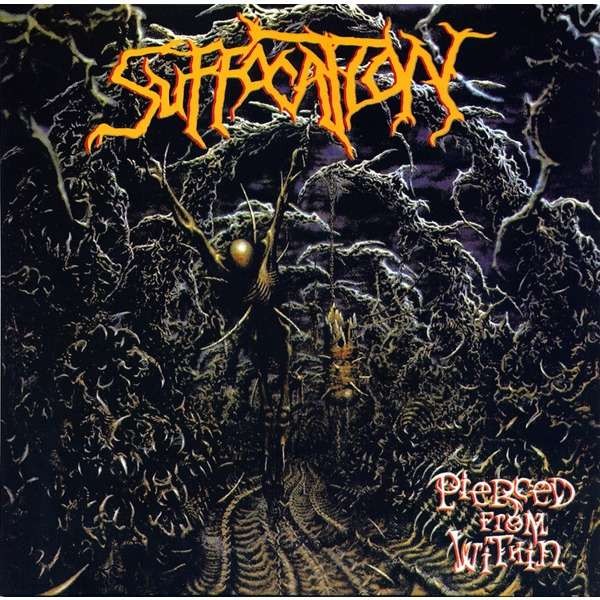
The title track of Suffocation’s third LP is a very interesting subject of analysis (as much as other excellent songs such as “Depths of Depravity”, “Suspended In Tribulation” or “Brood Of Hatred” from the same album could be) because it is a great example of recurrent motives reused in multiple different forms, of riff (musical ideas) progression and of narrative structure that ends with a climax and a release that brings a satisfying conclusion. The first step before going further is understanding how each idea of this song is crafted around the very simple and overused concept of two intervals a half step away from each other. The song is rather chromatic and has to be looked at with this idea in head.

In this case, as I will (try to) demonstrate, the most important interval is the major third, and then the perfect fifths/fourths. From this basis we can establish five constant elements that will be identified throughout the whole analysis.
- Element “a” is the collection of pitches that represent the major third intervals. Suffocation plays a lot with those intervals to create new motives and harmonies. It could also be considered as part of a harmonic minor scale (the last 3 degrees and the tonic).
- Same thing applies to element “b” but with the intervals of perfect fifths (and thus fourths), although the relation between the chromatic 5ths/4ths will gain another larger dimension sometimes.
- Element “c” is a diminished chord, something we will encounter frequently (Suffocation also uses frequently tritones and augmented fifth chords, especially in the Breeding The Spawn LP).
- Element “d” is a precise motive (and not collection) that finds meaning during the development of the song.
- Element “e” is just an ascending 3-notes chromatic scale that is used many times to partially conclude motives and phrases. It is of secondary importance.
I am not claiming that Suffocation used those leitmotifs very carefully and consciously like a classical composer would have, but my point is rather to show how, despite the lack of tonal material in the song “Pierced From Within”, unity was achieved between all components and how it creates a great song, structurally.
*From now on all the examples are in the F-clef*
Riff 1
The song starts with a long phrase at a fast tempo (riff 1) that is twice repeated. As shown in the score below, it is a mix of power chords and fast, technical strumming. We can see many manifestations of “a” as well as the repetition of rhythmic cells to create coherence. With its additional time, the last bar helps to generate an effect of oddness and temporal confusion through a more simple and effective way than modern bands trying over-technical rhythms and time signatures. This technique is used a few times in the song as you will see. Some have written the 3/4 as 12/8 but I prefer the former to adequately show rhythmic accents.
Riff 1 is followed by a short bridge made of an arpeggiated diminished chord (element c) and an augmented fifth chord (constructed upon two major thirds, suggesting “element a”).
Riff 2
From this long and complex riff, the music moves on to a generic “br00tal” verse (riff 2) where the vocals enter. However, it still manages to rhythmically catch interest due to the triplets at the end of the phrases.
Suffocation used different basic textures (tremolo, then muted power chords) to make both verses different while keeping the same harmonic outline, but this is not much of a big deal since the difference is not very flagrant:
Riff 3
Between the two verses appears riff 3(a), an intricate “melody” which marks a break for the vocals. This interlude introduces Suffocation’s technique of creating long musical phrases by the juxtaposition of motives that share different conclusions, yet constructed with the same material, as explained below. In addition of this, the different parts of the whole riff shift between “tonalities” or “regions”; where in the first bar the notes revolve around a certain fifth chord, in the next bar this fifth chord will be a semitone lower, hence the “larger” utilisation made of “element b” versus “a”. This is a very common (and cheap) way to make your material sound less repetitive when you are a bad and unoriginal death metal band, but in this song it becomes justified by the fact that the underlying concept of this technique is also used within a single part of a riff (and not only between parts) as the basis to craft multiple different melodic elements (just like the beginning of each bar in riff 3).
Right after our second verse, the song returns to the riff 3, but only for one bar because Suffocation shifts to a complete variation of it. While all the verses and riff 3a were written in 4/4, Suffocation adds another 4/4 bar after this first one (of riff 3b) and with the help of a drum fill switches to 6/8, once again destabilizing the listener. The ideas of riff 3a are then developed under groups of 6 sixteenth notes and constitute an even more intricate melody. Descending and ascending power chords bring us to an atonal cascade of notes which contains, of course, our previously identified elements rearranged in many ways. Mike Smith contributes to this by adding a lot of unexpected snare accents. Once again, Suffocation added a beat to the last bar to create the same effect as riff 1, but this time it is silent. This stop-start technique will be used a few times and is now an overused element of many technical bands. As usual, the whole riff is repeated with changes at the end to form a different and better transition.
Fun fact: the total of eighth notes comprised within the repetition marks of the riff is 47, a prime number, which proves the total irregularity of the “melody”.
Riff 3b, containing less literal repetition, brings us to what I called a “development”, because it is a short section of unique bars. Bar 1 and 4 are similar in concept, and the latter builds tension according to the former that will be released with another break and two violent snare hits. Between this, bar 2 and 3 offer chaotic rhythm where low palm muted chords meet high pitched tremolo notes and artificial harmonics. Notice that bar 1 uses what could be identified as harmonic minor scales, and thus suggesting our “element c” of diminished chords.
Riff 4
After this, riff 4 comes in as the powerful and savage release of the tension with its unmerciful tremolo phrases. You can see once again the technique of using different conclusions to the motive that starts each bar. On second repeat, the riff stays almost the same but emphasis is put on the phrases’ end with the removal of all instruments but one guitar to play the first beats of each bar, and with the addition of power chords on “conclusions”. The interesting element is right at the end of the riff: element d is heard very fast both times with both techniques. Then, again, the song stops and is followed by a slow, apocalyptic moment.
Breakdown and return
This moment is what I called (more or less rightfully) the “breakdown”. Now here is the trick: the first phrase of this section is exactly the same “element d” that concluded riff 4 but played way slower with power chords. Suffocation plays once again with textures and creates different accents with the use of palm mutes. And for another time, the last bar of the riff has an additional beat for your daily dose of rhythmic anarchy (or nihilism, as would say a controversial metal reviewer). This last bar present a rising chromatic phrase that we can interpret as developing “element d” and that presents a new 4-notes collection than in the first two bars. If you take those 2 pitches collections, you can notice that they are a major third away from each other (element a). I am not saying this was intentional or not, but I try to point out (coincidental?) links between all parts of the song.
The slow breakdown leads us to a sudden fast solo. I won’t analyze it here, but you can find a lot of “scales” constructed with “element a”. Listen also how the guitar sometimes melts with the triplets of riff 2.
The song returns to riff 3a, and then instead of continuing with riff 3b moves on to a new variation of the idea, riff 3c. This time, the riff takes a more urgent turn and creates the final tension, while Mullen cries the last lyrics: “I am your savior/Shapeless to your perception/For I am you/Pierced from within”. You can see how some melodic elements are now harmonized with major thirds. As usual, the second phrase (bars 3-4) uses a different conclusion.
After a repetition with a new ending, this rising tension is interrupted by a suspended chord that brings us to riff 1, played once. The song concludes abruptly before the end of the riff while the last words, “Pierced from within”, are repeated on the last four power chords. I did not talk much about vocals’ rhythm but it is cleverly constructed to fit the different parts of the song, and I am personally fond of how the lyrics are arranged in riff 3b.
Conclusions
As I said earlier, this approach might be over-technical and exaggerated, but the important thing for the reader is to at least understand how the song is well-crafted on every aspect and not entirely a sequence of random ideas. An analysis of a less technical song that contains great development would provide a good counterbalance to this article. Something out of Cianide’s The Dying Truth comes to my mind.
It is sad to think that after this album, Suffocation would never come up with anything on par with their previous material, because they certainly had to potential to improve and create new highly artistic pieces of aggressive and intelligent death metal. I still think their recent (post-reunion) albums are getting better each time and Pinnacle Of Bedlam, despite a terrible production, showed promising signs of great songwriting even though they apparently opted for a more tonal and melodic modern metal-like approach.
16 CommentsTags: analysis, death metal, Pierced From Within, suffocation
Independence Brewing Co. – Convict Hill Oatmeal Stout
As much as I enjoy a bitter beer, or an idiosyncratic one, Convict Hill Oatmeal Stout confuses the outward appearance of refined taste with the taste itself. An intensely sour and dark beer, it swings away from the pleasurable dimensions of beers toward small rooms full of “experts” who like highly demonstrative, artificed tastes. Such drinkers are looking for a beer to talk about how much they enjoyed, rather than enjoying it, while overpraising it like metalcore in a big heavy metal magazine. They will discuss its oddities, use vague terms like “creamy,” and generally miss the point: this beer is designed toward unbalanced extremes to make talking points, and has character within.
As a result, it makes a terrible everyday beer, and while it might be good as a Guinness substitute in a black and tan where a dark and bitter beer is necessary to offset the Bass or other pale ale used in contrast, by itself constitutes the same kind of unpleasant drinking experience that eating straight dark chocolate provides to the culinary palate. Like gourmet food that carries the pretentious epithet an acquired taste, this oatmeal stout misses out on the balance of a really good version of this sub-type, in which harvest flavors balance the bitterness to create a sense of transition, and instead aims toward something for gritted-teeth hipsters to use as a conversation topic when explaining the superiority of their taste to yours. At that it succeeds because there is so much to talk about but none of it is interesting. Take for example the separation of flavors so that the aftertaste is a tarry version of the foretaste; or perhaps, the strange fermentation overtones as if something random were included in the vat, or the process did not quite complete. Independent breweries are quite trendy now but this beer shows that it is not the size of the brewery, but the intent of the brewer, that makes a great beer instead of a faddish mediocre one.
Quality rating: 2/5
Purchase rating: 1/5
Tags: beer, convict hill, oatmeal stout

